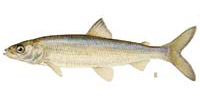For some of the finest trout fishing in the lower forty-eight states, venture over to Bighorn River. This river is known for its large catches. The white trout here grow to an average of 16 inches, with the brown trout averaging 15 inches. Bighorn River also offers fly fishermen the opportunity to catch huge fish year round. If you’re willing to brave the cold, ice, and snow, you can even catch large fish here in the winter.
In the first 13 miles below the dam, you’ll find the best trout fishing. The area below the Bighorn Access Site is where the current slows down, and the water temperature warms up. This makes the lower part of the river more of a warmwater fishery. In the summer and winter, you can catch catfish, whitefish, and bass in the lower portion of Bighorn River.
Trout can be fished along the entire Bighorn River, year round. Brown trout are most plentiful, though you may catch a trophy Rainbow from time to time. The river also has a large carp population. Before arriving, check the fish catch limits as they change often and can be very restrictive. Anglers can fish below the Afterbay Dam withing 200 yards using live bait and worms, but elsewhere on the river live bait is restricted.
Most angler fish artificial flies in Bighorn River. They also use streamer baits in cooler months, wet baits like freshwater shrimp, and hopper baits fished wet or dry. When using dry baits, dark midges work well because midge hatches occur year-round, and blue dun are effective when trout are feeding at the surface.
Access to the Bighorn River is restricted due to private land ownership. Head to the National Park for more public access and launching facilities, especially around the Afterbay Dam and the three-mile Lind access.















